TasteAtlas’ 2022 rankings for the world’s best cuisines, traditional dishes, and local restaurants were released on December 22, and they have proven more than a little controversial.
Commentators have criticized the lists by TasteAtlas, a travel guide highlighting “traditional dishes, local ingredients, and authentic restaurants,” for a myriad of reasons, perhaps most notably for the strong performance of American food on its global cuisine rankings.
American cuisine ranks as the eighth-best cuisine in the world, surpassing French, Chinese, and 85 other cuisines, an outcome that has generated a whopping 44.8 million views on Twitter.
Which one is your favorite?
— TasteAtlas (@TasteAtlas) December 22, 2022
Full top 95 list: https://t.co/194Xj0ZMZ4 pic.twitter.com/v4uYHnGzGD
According to its website, TasteAtlas assembled the ratings based on “audience votes for ingredients, dishes, and beverages.”
Who, exactly, made up this audience is not specified, but it clearly didn’t involve the social media masses, with a seemingly endless roster of Twitter and Instagram users railing against the results. Many have called the global cuisine rankings a joke and asked for a recount.
“England [is] higher than Thailand… What the hell is going on?!” wrote one Instagram user, while another chimed in, “Who is running this account? USA before France, Portugal, Peru, [and] China!!! Morocco [at] the end!! Ridiculous list.”
TasteAtlas’ list of the 100 best-rated traditional dishes globally is not being warmly received either. Some question how the U.S. ranked eighth for the world’s top cuisines, but not a single dish from the country made it onto the best dishes list.
In case you are wondering, eight out of 100 entries for traditional food came from China: tangbao, guotie, xiaolongbao, cha siu bao, shuijiao (or jiaozi), dan dan noodles, Peking duck, and shumai. Two Chinese dishes, tangbao and guotie, placed in the top five.
We’re glad to see both tangbao and xiaolongbao on the list. However, based on the pictures TasteAtlas picked, we’re not confident that the publication actually understands the differences between the two. (Read our illustrated guides to learn more about Chinese dumplings and noodles.)
Last but not least, TasteAtlas recommended a slew of local restaurants for 20 countries and regions, nominated by “renowned food guides, food critics, and Google ratings.”
For China, the agency highlighted five establishments: Hai Jin Zi (Shanghai), Hao Sheng (Shanghai), Jesse (Shanghai), Wang Fu (Hong Kong), and Xin Rong Ji (Beijing).
However, in a country with eight major cuisines and even more regional varieties, it feels like TasteAtlas did the Chinese mainland dirty by selecting only five eateries — three specifically focusing on Shanghainese cuisine. Meanwhile, both Germany and the U.S. have more than 40 highlighted restaurants.
Check out our FEAST section for more nuanced reporting on China’s F&B scene.
Cover image designed by Helen Haoyi Yu
















